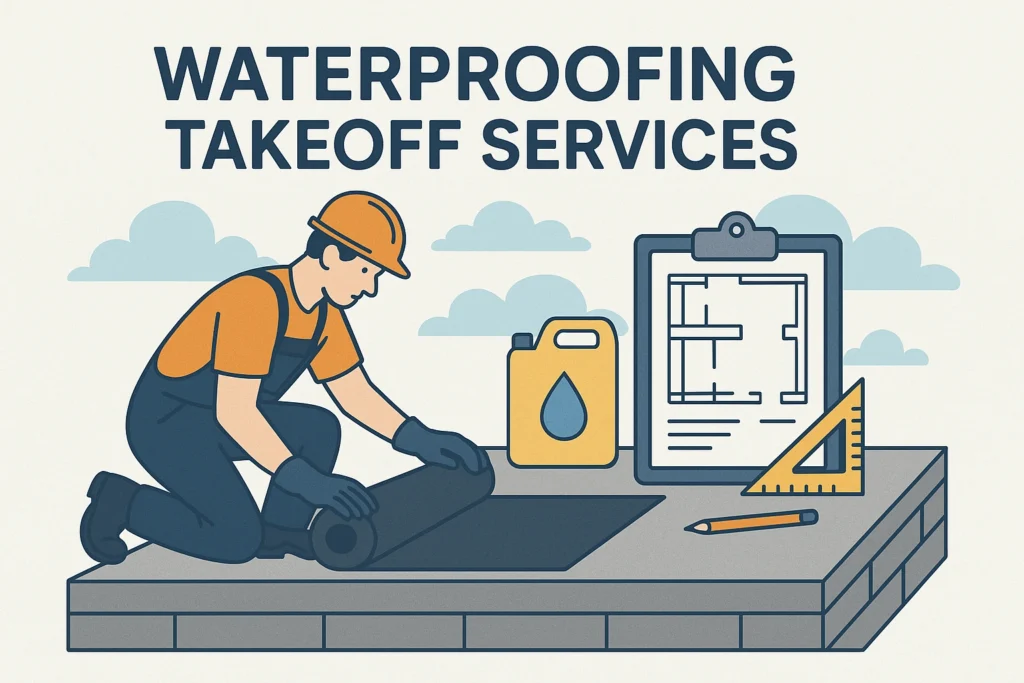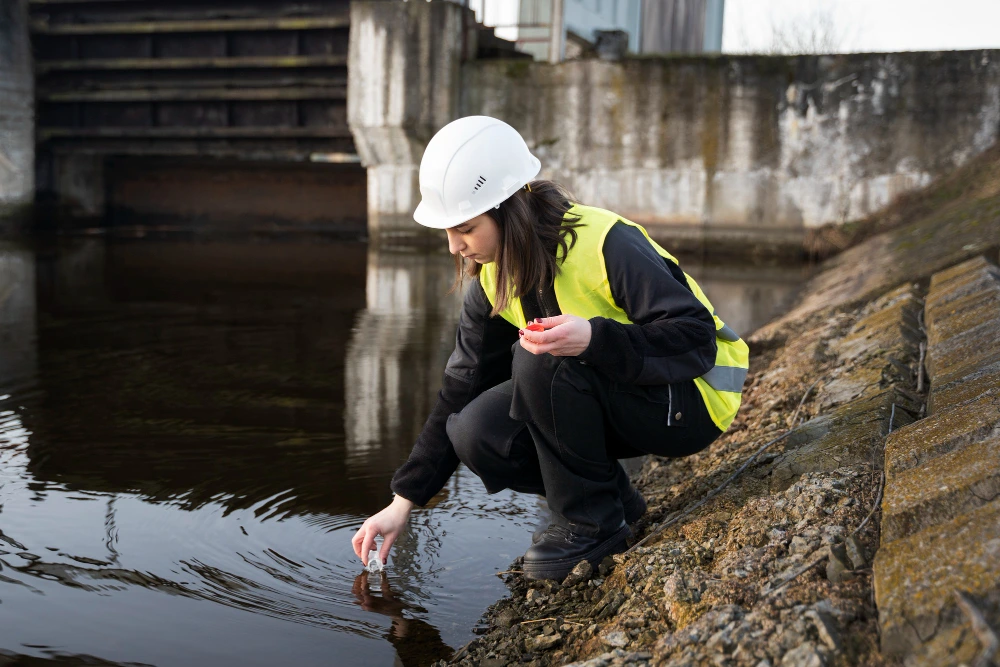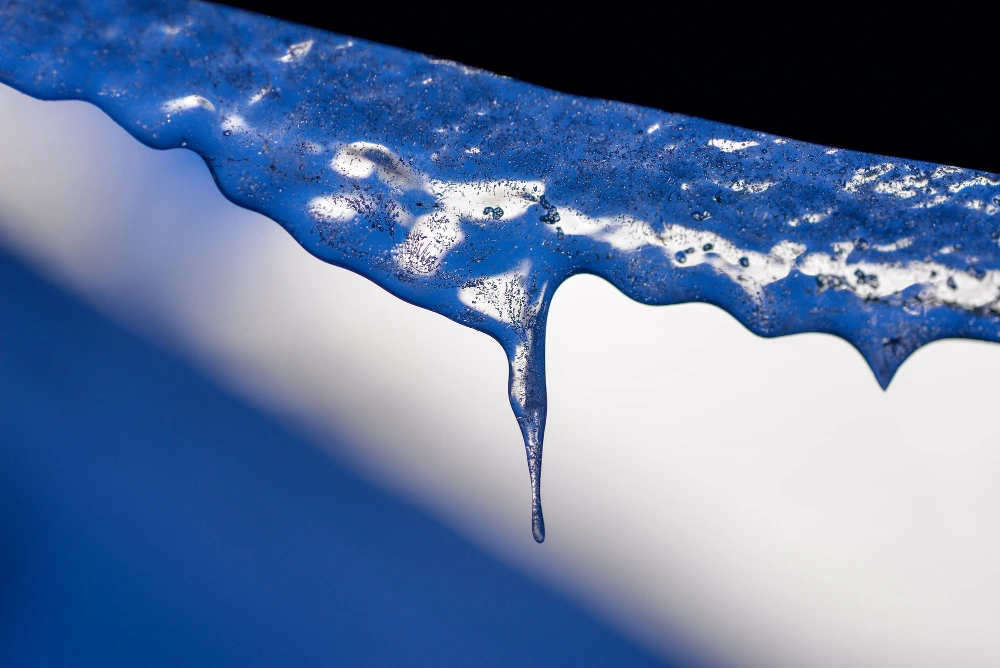Waterproofing Takeoffs Services
As a construction estimator, I can tell you that waterproofing takeoffs services are essential for any project where moisture control matters—think basements, rooftops, bathrooms, or foundation walls. These services involve a detailed breakdown of all the materials, quantities, and costs required to properly waterproof a structure. Whether you’re applying membranes, coatings, sealants, or drainage systems, a waterproofing takeoffs ensures nothing is missed. For example, on a recent commercial build, our takeoffs identified over 1,200 square feet of below-grade waterproofing not accounted for in the initial plans—an oversight that could’ve cost thousands in future repairs. Outsourcing waterproofing takeoffs to an expert estimator brings precision, saves time, and avoids costly rework. For general contractors and project managers aiming for accuracy and efficiency, investing in reliable waterproofing estimating services is a smart, risk-reducing move.
Our waterproofing Services
As a professional construction estimator offering services across the USA, I understand the critical role waterproofing takeoff services play in the success of any project. From basements to rooftops, these services ensure accurate material quantities, system selection, and cost forecasting—protecting against moisture damage and costly rework. Accurate estimates improve budgeting, minimize risk, and prevent scope gaps across sectors like commercial, residential, and industrial construction. By using digital tools and expert analysis, we help contractors streamline their preconstruction planning, win more bids, and build with confidence and long-term durability in mind.
Overview of Contents
Why Accurate Waterproofing Estimates Matter in Construction?
As a construction estimator, i known that accurate waterproofing estimates aren’t just about hitting numbers—they’re about protecting the entire project lifecycle. Waterproofing is often underestimated, but when errors occur, the impact is very expensive and long-lasting. Whether you’re a general contractor bidding on a job or a project manager aiming to stay on schedule, accurate estimating is critical for a successful project.
Here’s why it matters?
Risk Mitigation
- Prevents water intrusion-related failures, such as mold, corrosion, or structural damage.
- Identifies vulnerable areas early in the planning phase, allowing proactive measures.
- Reduces legal and warranty risks by ensuring compliance with waterproofing specifications.
Cost Savings
- Avoids over-ordering or under-ordering expensive waterproofing materials like membranes, sealants, and drainage boards.
- Cuts down on change orders caused by overlooked materials or scope gaps.
- Allows for better supplier negotiation with accurate material quantity forecasts.
Project Success
- Keeps the construction timeline on track by eliminating delays tied to rework or material shortages.
- Enhances stakeholder confidence through clear, well-documented estimates.
- Supports quality assurance with a clear roadmap of waterproofing scope and material needs.
Real-World Insight
On a multi-unit residential development, an initial bid excluded secondary waterproofing on balconies. Our accurate waterproofing takeoffs flagged the missing scope, saving the GC from a $40,000 correction post-construction. That one estimate prevented a major profit hit and preserved client trust.
Types of Waterproofing Systems Covered in Takeoffs Services
I’ve learned that not all waterproofing systems are created equal—each project demands a different solution based on structure, exposure, and design. That’s why professional waterproofing takeoffs services provide a detailed breakdown of all relevant systems to ensure accurate scope, budgeting, and material planning. From foundations to rooftops, here are the main types we typically include in waterproofing estimates.
Common Waterproofing Systems in Takeoffs Services
Below-Grade Waterproofing
- Applied to foundations, basements, and retaining walls.
- Critical for preventing groundwater infiltration.
- Takeoffs include sheet membranes, drainage boards, protection boards, and joint sealants.
- Example: On a recent commercial basement project, we accounted for 3,000+ sq. ft. of self-adhering sheet membrane and 400 linear feet of waterstops—missed in initial estimates.
Liquid-Applied Waterproofing
- Sprayed or rolled-on systems used on complex or irregular surfaces.
- Includes polyurethane, bituminous, or polymer-modified formulations.
- Estimated in gallons or square footage based on surface area and thickness.
Membrane Waterproofing (Sheet)
- Pre-formed sheets (typically bituminous or PVC) applied to flat or vertical surfaces.
- Offers high durability and uniform thickness.
- Takeoffs details include overlaps, laps, fasteners, and termination bars.
Cementitious Waterproofing
- Often used in water tanks, bathrooms, or concrete masonry.
- Easy to apply and highly compatible with concrete surfaces.
- Quantities are measured in bags or surface coverage, adjusted for thickness.
Bentonite Clay Systems
- Swells when in contact with water to form a barrier.
- Common in blind-side wall applications or where excavation access is limited.
- Requires specialized installation—accurate area calculation is crucial in takeoffs.
Real-World Insight
On a large healthcare facility, we identified that both sheet membrane and liquid-applied systems were specified in different areas. A dual-system avoided double-counting material and ensured the right system was matched with the right surface. That level of precision saved over $15,000 in material waste and avoided costly delays.

Step-by-Step Process of a Waterproofing Takeoffs
We’ve seen how critical it is to follow a structured, detail-oriented approach when preparing waterproofing takeoffs. Whether it’s a high-rise foundation or a rooftop deck, the accuracy of your waterproofing estimate directly affects cost control, schedule planning, and build quality. A proper takeoffs doesn’t just measure materials—it provides a roadmap for success. Here’s how we do it step-by-step, covering systems like below-grade, membrane, liquid-applied, and cementitious waterproofing.
Review and Analyze Project Documents
- Begin by studying construction drawings, specifications, and architectural details.
- Focus on sections that reference waterproofing scope—typically found in below-grade walls, slabs, podium decks, and wet areas.
- Identify which waterproofing systems are specified (e.g., membrane vs. cementitious).
Pro Insight: On a hotel project, early document review helped catch a scope conflict—membrane and liquid-applied were both listed for the same area. Clarifying it upfront saved rework.
Site Plan and Elevation Analysis
- Examine site plans, foundation layouts, and elevations to determine the full extent of waterproofing coverage.
- Pay special attention to transitions, penetrations, and below-grade elements like footings, elevator pits, and retaining walls.
Systems often involved:
- Below-grade sheet membranes
- Bentonite clay panels
- Liquid-applied barriers for complex geometry
Quantity Takeoffs and Measurements
- Use digital takeoffs software to calculate square footage, linear footage, or volume, depending on the waterproofing type.
- Adjust quantities for overlaps, wastage, drainage protection boards, and sealants.
Measurement Breakdown Example
- 2,500 sq. ft. of sheet membrane
- 300 linear ft. of termination bars
- 25 gallons of liquid membrane for irregular penetrations
Material and Labor Pricing
- Apply current market pricing for each material, based on system type and manufacturer.
- Factor in labor rates, installation difficulty, and access conditions.
Tip: For complex surfaces or below-grade installs, labor may be 2–3x more than flat surfaces—estimating this accurately prevents budget overruns.
Final Estimate Compilation and Review
- Compile material quantities, pricing, and notes into a professional estimate report.
- Double-check scope coverage and align takeoffs with client goals—especially when waterproofing is part of a larger bid package.
Real-World Example
On a large warehouse build, our takeoffs identified that an elevator pit was missing in the GC’s internal count. We added 80 sq. ft. of liquid-applied membrane plus vertical bentonite sheeting. That small catch prevented moisture issues and saved over $8,000 in potential water damage repairs.
Manual vs. Digital Waterproofing Takeoffs: Which Is Better?
As someone who started out with a scale ruler, highlighters, and physical blueprints, I’ve seen firsthand how much the estimating game has evolved. When it comes to waterproofing takeoffs services, the debate between manual and digital methods still comes up—especially for general contractors and project managers aiming for accuracy, speed, and cost control. Let’s break it down and see which method holds up better in today’s construction landscape.
Manual Waterproofing Takeoffs (Old-School Method)
Manual takeoffs rely on printed plans, calculators, and hand-written notes. While they’ve served the industry well for decades, they come with serious limitations in today’s fast-paced, tech-driven world.
Pros
- Familiar for experienced estimators
- Useful for small or straightforward jobs
- No software costs involved
Cons
- Time-consuming and prone to human error
- Difficult to revise when design changes
- Challenging to share or collaborate remotely
- Accuracy suffers on complex waterproofing systems (e.g. overlapping membranes, curved surfaces)
Real Insight: On a large residential project, a manual takeoffs missed over 300 linear feet of sealant detail in balcony transitions. The oversight led to budget overruns and scheduling headaches for the GC.
Digital Waterproofing Takeoffs (Modern Software Solutions)
Digital takeoffs software like PlanSwift, Bluebeam, or STACK has transformed how we handle material quantity takeoffs. These tools allow estimators to quickly calculate areas, lengths, volumes, and generate detailed reports with high precision.
Pros
- Faster and more accurate measurement of waterproofing components
- Real-time updates and revisions
- Integration with estimating and project management tools
- Easier to apply waste factors, overlap allowances, and labor calculations
- Sharable files for teams, subs, or clients
Cons:
- Requires upfront software investment and training
- Still depends on the skill and experience of the estimator to interpret specs correctly
Manual vs. Digital: Side-by-Side Comparison
| Feature | Manual Takeoffs | Digital Takeoffs |
| Accuracy | Moderate (error-prone) | High (automated calculations) |
| Speed | Slow | Fast |
| Flexibility for Revisions | Low | High |
| Collaboration | Limited | Easy to share & update |
| Material Waste Consideration | Often missed | Easily included |
| Cost Estimating Integration | Manual entry | Software-assisted |
If you’re managing complex construction projects, working with tight budgets, or aiming for precision in waterproofing scope, then digital services are clearly the better path forward. While manual methods may still work on small-scale jobs, the benefits of digital tools—especially for below-grade waterproofing, liquid membrane systems, and bentonite applications—are simply too valuable to ignore.
In the modern construction industry, digital waterproofing takeoffs offer a competitive edge through enhanced accuracy, faster turnaround, and seamless integration with bidding and project workflows. If you’re still relying on rulers and red pens, now’s the time to upgrade. Whether you’re doing it in-house or outsourcing, choosing the right method can save you time, money, and headaches down the line.
Common Mistakes to Avoid in Waterproofing Estimation
When it comes to waterproofing estimation, small mistakes can lead to big, costly problems—especially if you’re relying on guesswork or outdated plans. Over the years, I’ve reviewed hundreds of project bids and estimates, and I’ve seen how critical it is to get this scope right from the start. Whether you’re a general contractor trying to protect your bottom line or a project manager overseeing a tight timeline, knowing what not to do can be just as valuable as knowing what to include.
Top Waterproofing Estimation Mistakes to Avoid
Overlooking Surface Preparation Requirements
- Many estimators forget to account for primers, cleaning, or surface leveling, which are essential before applying most liquid-applied membranes or cementitious coatings.
- Ignoring prep can lead to adhesion failure and costly rework.
Real Insight: On a hospital foundation job, skipping prep cost the contractor over $10,000 when the liquid barrier peeled due to dust-contaminated concrete.
Underestimating Material Overlaps and Waste Factors
- Membrane systems (like bituminous or PVC sheet) require overlap allowances—usually 2″ to 6″.
- Not factoring in overlaps, cutouts, or waste can cause under-ordering and material shortages during installation.
Pro Tip: Always add 5–10% for waste allowance based on surface complexity.
Not Accounting for Transitions and Detail Work
- Areas like pipe penetrations, corner joints, and elevator pits need special detailing, which adds time and materials.
- These “minor” areas often lead to water ingress if not properly estimated and detailed.
Real Example A multi-unit residential job had 30+ unaccounted pipe penetrations. Correcting it post-bid added $7,500 in flashing and labor.
Relying on Generic or Incomplete Plans
- Estimating waterproofing scope from incomplete or schematic drawings leads to inaccurate takeoffs.
- Always verify with the latest construction blueprints, specifications, and manufacturer guidelines for compatibility.
Ignoring Installation Challenges in Labor Pricing
- Labor costs vary by application type, surface accessibility, and weather conditions.
- Applying a flat labor rate across all surfaces—like vertical walls and underslab areas—will skew your cost estimate.
Pro Tip: Use historical cost data and local wage rates for realistic estimates.

How to Avoid These Mistakes
- Use takeoffs software to measure areas precisely.
- Review site conditions and ask clarifying questions early.
- Include all accessories, protection boards, primers, and sealants in your bill of quantities.
- Consult with suppliers or manufacturers for system-specific installation guidance.
Industries That Rely on Waterproofing Takeoffs Services
In construction, waterproofing isn’t just a finishing task—it’s a foundational requirement. As a construction estimator, I’ve worked across multiple sectors, and one thing is constant: waterproofing services are vital across industries where structural integrity, safety, and long-term performance matter. Whether it’s a shopping mall slab, a residential basement, or an industrial tank, an accurate waterproofing estimate helps control costs, avoid delays, and protect the building envelope from moisture intrusion.
Commercial Construction
- Office buildings, retail centers, hospitals, and hotels require high-performance waterproofing systems for roofing, foundations, podium decks, and wet areas.
- Complex plans and phased construction schedules demand precise material forecasting and sequencing.
Typical Waterproofing Elements:
- Below-grade sheet membranes
- Liquid-applied roofing systems
- Drainage composites and flashing accessories
Estimator’s Insight: On a retail development in Chicago, accurate takeoffs of 5,000 sq. ft. of roofing membrane and 900 linear feet of flashing helped the GC avoid $18,000 in excess ordering.
Residential Construction
- From single-family homes to multi-family apartments and condos, residential waterproofing protects basements, balconies, crawl spaces, and bathrooms.
- Mistakes in estimating here can lead to costly repairs, occupant discomfort, or mold litigation.
Commonly Used Systems
- Cementitious coatings for bathrooms
- Liquid-applied membranes on balconies
- Bentonite sheets in basements
Industrial and Infrastructure Projects
- Factories, power plants, wastewater treatment plants, and storage facilities often have specialized waterproofing requirements.
- These include chemical-resistant membranes, large-area slabs, and fluid containment zones, where failure is not an option.
Scope Includes:
- High-performance elastomeric membranes
- Protective coatings for containment tanks
- Vapor barriers under heavy slabs
Estimator’s Insight: On a chemical processing plant, we calculated over 12,000 sq. ft. of high-spec fluid-applied membrane—missing even 5% would have compromised the entire containment zone.
Other Sectors Benefiting from Waterproofing Takeoffs Services
- Education: Schools and universities need waterproofed roofing, bathrooms, and mechanical rooms.
- Healthcare: Hospitals must meet hygiene and flood-prevention standards.
- Hospitality: Hotels demand waterproofing in spas, pools, bathrooms, and terraces for long-term durability.
Why Outsourcing Matters
Outsourcing waterproofing quantity takeoffs services ensures:
- System-specific scope coverage
- Accurate cost estimation for materials and labor
- Reduced risk of rework and scheduling delays
- Full compliance with project specs and local codes
No matter the industry, accurate waterproofing takeoffs are a cornerstone of successful construction projects. By aligning your estimates with building function, environmental exposure, and system complexity, you set the stage for quality, durability, and financial control. Whether you’re building a hospital or a home, working with a seasoned estimator brings clarity, confidence, and competitive edge to your waterproofing scope.
Summary-Waterproofing Takeoffs Services
No matter the industry, accurate waterproofing takeoffs are a cornerstone of successful construction projects. By aligning your estimates with building function, environmental exposure, and system complexity, you set the stage for quality, durability, and financial control. Whether you’re building a hospital or a home, working with a seasoned estimator brings clarity, confidence, and competitive edge to your waterproofing scope.

